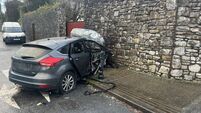Hidden life teeming in our waters
Not being a deep-sea diver, I have never previously found myself within touching-distance of giant rays and skate swimming leisurely past me — indeed, I touched one as it surfaced nearby. Their grace, and the intricate and beautiful patterns with which nature has endowed them, held me in thrall as I stood at the edge of the large, open tank in which they swam.
While the open tanks, with water only a couple of metres deep, made the experience ‘close-up and personal’, the fish behind glass, in huge aquariums, were equally thrilling to watch, the shoals of big bass and pollock, and conger eels as long as two metres and as thick as one’s thigh reclining in weed-grown concrete pipes, their homes.
If I lived in Galway, I would haunt the Atlantaquaria; meanwhile, for those who, like myself, love the sea and are forever curious about the creatures that inhabit it, I can recommend a lovely and scholarly book, published by Sherkin Island Marine Station in west Cork’s Roaring Water Bay.
Ireland’s Hidden Depths is a volume of photographs taken beneath the sea. It is packed with visual and textual information, pictures worth a thousand words and words that reinforce the images.
The photographs are breathtaking. As we turn the pages, the beauty of the unearthly world we land-lubbers never see is brought alive through the skill of cameraman, Paul Kay. Photographer’s lights catch the inhabitants in their day-to-day lives, feeding, mating, displaying, peeking out at the photographer with almost human curiosity.
Complementing the images are fascinating facts conveyed in notes on the natural history and physiology of the creatures photographed.
Hidden Depths is not another coffee-table volume long on pictures, short on information. It is a book of substance, the product of the internationally respected Marine Station. The text is as important as the pictures; it was compiled by experts but is accessible and easy to read. The agenda of Paul Kay and of Matt Murphy, the founder and director of the marine station, was to demonstrate the diversity and specialisation of the creatures that live in our national seas. The result succeeds on every count.
Most of us do not know that The Real Map of Ireland — as graphically displayed on a postcard for sale at the Galway Aquarium — extends 1,000 km west of Achill and 550 km south of Beara. Ireland’s underwater territory is six times the area of its dry land.
Paul Kay first came to Sherkin Marine Station as a volunteer to photograph built heritage. What he saw in the station’s aquariums inspired him to take a camera beneath the waves. The result is up close images of all manner of sea creatures. Chapters detail the families of anemones, crabs, starfish and their near-relatives; fish and shell fish; sponges, squirts and marine worms; oceanic plant life, rock gardens, rock pools and the environments of the sea shore.
Turning the pages, I marvelled at the underwater glory of our lowly dragonets, of plumose and eyelash anemones, at the grace of compass jellyfish as they swim, the beauty of light-bulb sea squirts and the sea cucumbers. I also learned a great deal.
Twenty years ago, when I returned to Ireland and settled by the sea, I kept marine aquariums and studied intertidal life. However, this volume tells me much that I didn’t know: that sea urchins have pinchers growing between their spines, that a creature called Thor’s scaldfish has the trick of entirely shedding its scales when netted, that the gobies of Lough Hyne in west Cork — where topography has created a natural marine aquarium — are unique in their diversity.
Ireland’s Hidden Depths is a keep-sake testament of our marine heritage and a credit to the publisher. It retails at €17.99, half of what coffee-table volumes normally cost.
Printed in A4 landscape format on high-quality paper, the colour reproduction is faultless throughout, with a glossy, full-colour cover in heavy card and with substantial flaps. I shall be buying copies for Christmas presents. Like the anemones and fanworms it portrays, this book is a gem.















